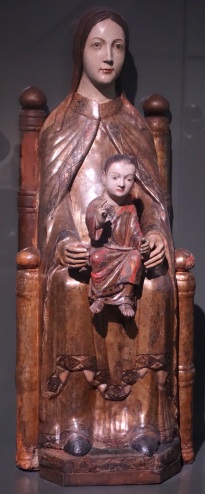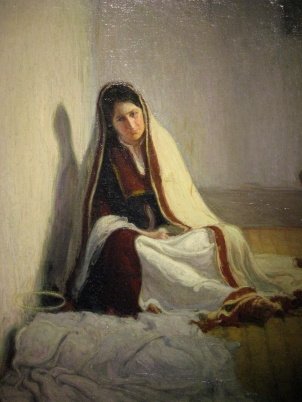A Reflection on Mary as the Seat of Wisdom (Sedes Sapientiae) & the Naming of Saint Mary’s College
by
Professor Anne Carpenter, Ph.D.
It is a paradox, perhaps unnoticed by most, that a Catholic institution of higher education would choose a poor, illiterate Jewish woman as its patron. Yet it is a paradox that Catholicism cannot make sense of itself without: the one who was “lowly” and “humble” is the guardian of all wisdom, treasuring it in her heart.

Catholics love the Virgin Mary, and that is certainly one reason to name a place after her. She is the “Mother of God” (Theotokos), which is her oldest formal title, and she holds a special place in Catholic imagination because she was the one who bore Christ, brought him into the world and nurtured him. This does not quite tell us why Catholics might associate her with education in particular, but it is a start.
For early Christians, it mattered that Mary was poor, that she was a woman – and so occupied a “second” place next to men – and that God chose her, and not someone else, to be his earthly mother. “Blessed are you who are poor,” says Jesus in the Gospel of Luke, “for the kingdom of God is yours” (6:20). God prefers the poor. He preferred her. Not in spite of her poverty, but somehow within it, so much so that he made human poverty his own: “For you know the gracious act of our Lord Jesus Christ,” writes Saint Paul, “that for your sake he became poor although he was rich, so that by his poverty you might become rich” (2 Cor 8:9). This great act of God’s is sometimes called the admirabile commercium, the “wonderful exchange,” whereby God adopts our status (poor, bruised, rather lost) in order to give us his (glory, life, abundance). Mary is a symbol of this “exchange” because she lived it.

So it is that Catholics have a long history of exalting and protecting the poor. There is an old legend about the deacon Saint Lawrence, who, during persecution in Rome, was asked to hand over all of the treasures of the church. Lawrence gathered the poor of Rome and presented them to the authorities. “These are the treasures of the church,” he said, quite seriously. He was killed for it, naturally.
This helps us to understand why the Christian Brothers might be devoted to Mary, who was poor, and it helps us to understand why they are so firmly dedicated to teaching the poor. To love the poor is to follow the logic of God himself.
Yet Mary is also considered wise, and she is considered a source of education. She is not only loved because she is poor-yet-dignified. For Catholics, she is at the same time fearsome in her wisdom. She displays this in a number of ways, the most important of which can be found in her very life: Mary had the kind of wisdom and faith that allowed her to agree to God’s plan, despite all it risked. As her cousin Elizabeth says to her, so Catholics continue to say, “Blessed are you who believed that what was spoken to you by the Lord would be fulfilled” (Lk 1:45). To believe in this way takes incredible wisdom. Most of us struggle like the man in the Gospel of Mark – “I do believe; help my unbelief!” (9:24) – but Mary resembles the advice from the Book of Wisdom: “Those who trust in him shall understand truth, and the faithful shall abide with him in love” (Wis 3:9).
Mary’s wisdom is sometimes lost in more endeared, saccharine forms of devotion to her. We perhaps imagine a soft mother, which is not untrue, but which – to include the wider breadth of the Catholic tradition – needs to include her wisdom. An ancient title for Mary is Sedes Sapientiae, “Seat of Wisdom,” and this is a play on images. Mary is the “seat” of wisdom because she held divine Wisdom, Christ, in her lap as his mother; she is also the seat of wisdom because she knows what it is to hold and love wisdom, to be wise. If a Christian desires wisdom, they must sit at her feet as Christ himself did.

This brings us to a final point of interest when it comes to Mary and education: by the time the Middle Ages arrive, Mary increasingly emerges as an educator in her own right. A confluence of traditions formed this image. Not only was Mary the Sedes Sapientiae, but it was also the case that women in the Middle Ages were the primary educators of a household, especially when it came to literacy. Mary is increasingly depicted holding a book with the Christ Child in her lap, pointing out the words to him, teaching him to read. It is an old artistic trope by the time of the Italian Renaissance: Mary is the supreme educator, the first giver of wisdom to a child of faith.

It is true that Mary was, historically, most likely illiterate. Yet it would be a disservice to that same history to frown or sneer at depictions of her as deeply literate. This is more than historical fancy or inaccuracy. It is long centuries of meditation on a personality, on a youthful “nobody” wiser than any of her peers, who comes to represent the paradoxes of wise faith. It is many ages of struggling to hold that paradox close, and to see not only that all are worthy of education, but also that wisdom is hidden in the unlikeliest of places.
It takes real wisdom to know where good things might be found, and to see glittering false things for what they are. Pope Francis likes to call this “discernment.” It is wisdom that knows how to discern between sand and solid ground. This is the difference between a mere education and real, discerning learning. And so, for an institution that desires to give such wisdom, there is perhaps no better patron than Mary.

photo credits: Wikimedia Commons and Brother Charles
Thank you for this beautifully stated insightful reflection. Wonderful for meditation.
LikeLike
Thanks for this profound reflection on Mary. The artistic representations are a great testimony to how she has been revered for many centuries.
LikeLike